Russia Ukraine War - A Strategic Update
At times we have been far-sighted, now the same faculties tell us Zelensky is unlikely to choose wisely as Trump takes the reigns.
Article Version of thread first posted on Jan 19 2025
Let us review a strategic update. Discussing the main fronts, and a look forward. Things mostly have been developing as we discussed earlier.
Starting with the Kursk salient, we have the continued gradual shrinking of the salient. Ukrainian command continues to hold on to it for dear life, sending some of its best brigades to the front to the detriment of the deteriorating Donbass fronts. In typical fashion they are acting as if a Trump inauguration with UA forces within old Russia indicates a strategic achievement.
In fact the opposite is true. As we discussed in this and earlier posts,
Russia, the Clock & the Upcoming Trump Administration
Article version of (my typically prophetic!) original post on November 14 2024
(here an excerpt:)
a Trump administration before Russia has achieved it's desired territorial goals, actually potentially complicates matters for her.
In short, the problem is that when Trump proposes a ceasefire along current lines, Russia would have to reject the proposal if it wishes to yet advance further. UA forces within "old" Russia, simplifies this for Putin quite a bit. No one would expect that Russia would or could accept the current lines if they include losing parts of pre-war Russia. Now of course, if UA forces were making a strategic difference here, facing a collapsing Russian line or were a few kilometers from Moscow or at least another major city, that would be something else. But as is common for Kiev, the PR win IS the goal.
Despite the fact that the proposal on the table is likely to be a ceasefire along "current lines", the Zelensky regime still plays only for time. Despite the very obvious fact that the proposal literally gets worse for it every single day, as Ukraine loses ground every single day. With such a powerful backer (the USA), the proposal should be very attractive for Ukraine, as it promises to stop its daily shrinking, not to mention destruction and loss of life. If it did quickly grasp this option, it would complicate matters for Russia, as the ball would be on her court, and pit Putin vs Trump. It even would potentially activate a sort of territorial "put" (insurance), because as it continued to lose additional territory, while Russia rejected the plan, it could continue to argue its acceptance of the plan was at the previous lines and might even find support for this position in a Trump administration, whose overtures for peace had been rebuffed by Russia.
Strategic thinking not being a high priority in the entitled [Zelensky] regime, we instead saw a renewed offensive just days ago to deepen the UA Kursk salient. We have discussed previously that where the front agrees with the internationally recognized border, Russia tends to enjoy a strategic advantage of not having to defend it as densely as Ukraine does.
So a new surprise offensive elsewhere is not necessarily a bad idea by Ukraine. But I was surprised even at UA command when I saw them double down in the same salient. The element of surprise is virtually zero. The pocket is narrow, and supported only by one road leading to the Sumy region. Even if the advances succeeded, which of course
they didn't (that did not stop us from being told otherwise of course),
(over and over…)
what could it achieve other than placing even more brave troops (those who weren't casualties) in danger of encirclement?
Of course, the UA forces were not completely without innovation, the columns advanced with powerful new EW equipment to stop the Russian drones. We have already seen for the past few months, an increase in Russian fiber-optic drones which evade all EW countermeasures.
Rather than rely on RF communication, which is susceptible to jamming, it communicates through
a thin, flexible and very long optical fiber cable. As the UA offensive got underway, Russia nimbly rushed fiber-optic FPVs (and units) to the front, and they quickly rained down unsustainable damage on the advancing columns.
Apart for the PR achievement, I suspect the offensive also meant as a test case for this new EW equipment. It seemed to perform rather well against the older RF FPVs, but Russia was already playing a different game. Interestingly, we have not yet seen Ukrainian fiber-optic FPVs.
I assume much has been reported on the optical fiber drones' ability to evade EW countermeasures. This is certainly an advantage, while the disadvantages of the physical cable connection both in operational limitations and cost are also fairly obvious.
However, I can inform you from personal experience that the most crucial advantages these new drones posses are not related to its immunity to EW (at least in the current battlefields where complete EW dominance across the fronts does not exist).
The first underappreciated and crucial advantage is related to signal strength, but not to jamming and EW.
Invariably, FPV drones drop down to hit their targets. At these low altitudes, they often are behind (relative to their controllers and/or their antennas) buildings, trees, terrain features and the like. They lose line of sight and they lose signal.
It takes skilled controllers to be able to hit targets after having lost video connection in the final approach. Even in the relatively flat terrain of Ukraine, the advantage of calmly surveying and maneuvering over the terrain before striking, even while a few meters or less off the ground, with perfect signal strength, is a huge advantage.
Secondly, there is the video resolution. It is hard to imagine the difference of viewing the enemy-held territory in 720p+ (or even 4k), resolution (and static free), compared to the average low quality analog video feed transmitted by most FPVs.
Far from the complaint of a "spoiled" operator, it represents night and day in terms of effectiveness. It is hard for a person to imagen how difficult it is to recognize enemy positions, equipment and personnel during combat operations. You can look at the highest resolution satellite imagery available to get an idea. Despite a half meter resolution, you will not easily find even the tiniest percentage of the thousands of armored vehicles spread along the huge front, nor will you easily see any troop concentrations.
Likewise, identifying a hidden, camouflaged enemy (who wants neither to be seen nor die), from above, is rather difficult, even with good resolution. With a poor camera and RF connection, it is exponentially so. The added bandwidth the optical cables provide, is not being wasted, but rather intelligently used to accommodate higher resolution cameras on the suicide drones.
Part II - Additional Fronts
In the Kupyansk region, RU forces have crucially established a foothold on the west bank of the Oskil river. This opens up several possibilities as we have discussed before.
To begin with, this allows an advance on or flanking of the city from the north and west.
As we can see on the map (Suriyakmpas), RU forces are already at the P79 highway and can advance on the H26 highway (the Kupyansk - Kharkhov road), thereby cutting off not only the critical hub of Kupyansk, but also the entire UA salient east of the river it supports. Additional moves towards the SE can complete the encirclement and collapse the salient. Furthermore, besides threatening Kupiansk, the move puts Russian forces in the free operational space with various options.
They may advance west or NW to meet up with forces from Vovschank and cut off a large chunk of the Kharkhov oblast in eastern Ukraine. UA fortifications here are not impressive, and for the moment, the question is whether Russia can increase the number of units in the western foothold, and establish a higher capacity of logistics before UA forces can establish strong fortified lines blocking the Russian breakout before it gets started. A bit further south in the long Kupyansk (or Kharkhov) front, we have a similar situation.
Having realized that the obvious advance was banging your head against the wall (the thin arrows),
the Russian forces unexpectedly pushed westwards across the Zherebets river (& the reservoirs). By this move, Zarichne and Torske are threatened from the flank (from the north & west), and neither are now the only gate to Lyman.
This move complicates UA defenses considerably as they must be split up. This maneuver which we see twice in this front, indicates just how much the relative manpower situation has changed. Previously, Russian forces clung to river banks and reservoirs, since they eliminated a flank (to a degree at least) to have to defend. During bad times, we saw Russian forces retreat to lines of defense along rivers, canals and lakes, and in better times like to advance along their length, as they guarded one flank and allowed concentrating power forward.
Ukraine tended to ignore them and press it advantage when it could as far as possible, posseting plenty of manpower. That is how we end up with UA forces on the eastern banks of the Oskil and Zherebets rivers. Russia had attempted to hold the line along them when its Khakrhov front collapsed earlier in the war.
The fact that now RU units now leave and force these defensive lines, to advance thrusts into midst of UA held territory on every side is very telling. It also shows a much improved logistics apparatus on the Russian side. We constantly see, in all sort of weather, RU forces advance deep into UA territory far from roads, and across creeks, wadis and even rivers. They do so while maintaining the ability to advance further and expand the "bloom" in many directions.
Ultimately, we ought to remember that the long Kupyansk front is important in the battle for Yampil, Lyman and perhaps even Izyum; the gateway to reaching behind Sloviansk from the north and the final battle for the Donbass. Likewise, crucial in flanking and defeating the uncrackable expertly held UA Siversk front.
This crucial Slovyansk is the northern end of the Sloviansk - Kramatorsk - Kostyantynivka line; the final major defense line of the Donbass. In the south, two major RU offensives are pressing the line's demise.
First, the advance on Chasiv Yar continues. Here once again the UA forces face encirclement if they do not withdraw.
RU forces will quickly encircle the strongly fortified industrial zone of the city. Additional RU advances may encircle UA forces in the forests SE of the city.
Chasiv Yar is strategically important as it is well served by railway, while being relatively high, as opposed to nearby and hard fought Bakhmut, which is much lower.
This is one of the reasons the uphill battle for Chasiv Yar has been so difficult. Control of Chasiv Yar gives RU forces access to advance northwards & eastwards along the high ground controlling the Sloviansk line, as well as a railway on which to advance along (as RU forces like to do). Finally, it is a strong foothold on the west side of the canal. Of course, the defense positions on the Slovyansk line are east of the cities, and on the high ground themselves, which is why what is happening south of Chasiv Yar is much more important.
Part III - Toretsk, the Unlikely Prospect Zelensky Chooses Wisely, & More
We start with perhaps the most underrated and underreported part of the front. Toretsk. We have discussed it at length previously.
https://x.com/ZimermanErik/status/1643272528863850496
The line we call the Slovyansk - Kostyantynivka line, we used to refer to as the Slovyansk - Toretsk line.
It is Toretsk that represented the strongly fortified southern anchor of that line. It has taken a long time for RU forces to overwhelm it, but its capture is crucial and strategic.
In the above referenced thread back in April 2023, we discussed how the path West around or through Toretsk was of such importance, as it lay in the way of the H20 highway.
The other pincers we discussed then, have already progressed, towards Prokrovsk indeed, and it is the Toretsk pincer that is only now ready to break out. In the thread we discussed how breaking through Toretsk would be very difficult, and how perhaps going around it was possible, though perhaps too narrow a corridor to sustain.
In the end, RU forces did go through the city, and it took a very long time indeed. In the meanwhile, the changing dynamics of the war have made advance through cities, especially areas without high rises and industrial complexes, much more feasible than earlier in the war.
Not long after this analysis, I discussed this changing dynamic.
The changing dynamic of Advance and Defense
This is an article version of what was originally posted in a long thread:
While the UA command was slower to grasp this and other dynamics, the Russian command quickly adapted. Through Toretsk it was.
Various Ukrainian brigades and units have rotated in and out of this front. Some fought extremely professionally, and a few not only held the front but were able to push RU units back at certain times. This helped to lengthen the battle for the city. Yet today it is finally in Russian hands (over 90% of it anyways).
In the April 2023 thread (referenced at the top of Part III), we referenced (via this Feb 7 thread), an even earlier post from July 2022.
Incredibly, back then we highlighted the importance of a westward thrust towards Pokrovsk through Ocheretyne.
Adding only the green to this 2022 post (at https://x.com/ZimermanErik/status/1546326598655295489), we can see the central advance through Ocheretyne (towards Pokrovsk), as well as the suggestions of going around, rather than going through, Avdiivka and Toretsk. In the event, there was a successful RU effort to surround Avdiivka, including cutting it off from the northern supply routes. In Toretsk, RU forces plowed through and took a very long time.
Posted the following image back in April 2023. The question mark is original, indicating the difficult choice RU forces faced for this critical advance. Would they try to force the narrow corridor between the large urban areas and/or push through Toretsk itself? In the end, they did just that.
Also back in 2023, we discussed the following image, the green newly added. The key is clearly Pokrovsk, and the main axis of advance are clearly through Ocheretyne, Khurakhove, Selydove and Toretsk.
Much as it has occurred (and some yet likely will).
Much later, starting in May 2, 2024, when the town's fall was about to occur, I predicted the imminent "bloom" to follow the capture of Ocheretyne.
Elaborated further in this thread:
https://x.com/ZimermanErik/status/1787012548383887752
(excerpt)
So here we are finally today. What is left to develop from those discussions and projections? The breakout west from Tortetsk.
Here are some potential major & minor RU routes of advance, but there are two main ideas at work here.
First, that a push westwards from the Toretsk - Niu-York front towards the H20 and H32 roads will collapse the UA Horlivka - N. Donetsk city fronts. Furthermore, pincers moving northwards from Toretsk can close with those southwards from Chasiv Yar.
These are both relative high-grounds and can encircle UA units defending along the strong canal line. The important thing here is not (at least not only) the potential for a very strong and fortified front to collapse, but what lies beyond.
We have discussed Russia's election to, on a strategic scale, blast through the most fortified parts of the
front, likely due to political reasons. This being the case, Russia is doing a good job trying to avoid the worse of it. Earlier on it was impossible, as it pounded lines that have been established and strengthened since 2014. Lately it is reaching operational space in certain
areas, and can start to maneuver. Beyond Toretsk and Niu York it previously was open space. But UA has been hard at work. Well not as hard as it should have been, given the dollars spent, but though far from adequate, some new lines have been built.
Let's take a look at the Military Summary map, which does a good job at mapping new UA (and RU) defensive lines. At first it might seem like an impossible mess. But if we take a closer look, we can see that the "great beyond" is still accessible to RU forces. Its armored columns may yet breakthrough "into the blue", after years of grueling and bloody trench battles.
The reason being that at this stage of the war, defense in depth is everything. Lines lacking depth, and specifically not having fully built second, third, fourth & even five fallback lines, are of little use.
As soon as RU realized it would need time to grow its army & strength to win this attritional war, and that it would face further UA counteroffensives, it set out to build the Surovikin Line, at great effort, cost and with remarkable speed. This is defense in depth, across the the front. The best of newly minted & Western trained/armed/supplied brigades smashed themselves to bits against it. What the UA command has built here is nowhere near adequate.
You see, when there is no depth to the defensive line, the problem is not just the obvious. Once the enemy forces can get on 2 or better yet 3 sides of the line, it actually serves as a highway for their advance. As we have discussed at length, advance in the open at this stage of the war is very costly if not impossible, as long as there is even a lightly entrenched foe in determined opposition. To move is to be seen, and to be seen is to be destroyed in this modern battlefield. However, a thin line of fortifications that can be flanked on several sides offers a good axis of advance.
This is similar to how RU forces like to advance along railway lines. We have already seen this play out in several places, including during the ongoing RU advance & flanking of Pokrovsk (one of 2 last fronts we still need to cover in Part IV or V).
An additional line, or fortified positions near & parallel to the first, make this maneuver a much more difficult proposition. Fire from one defensive line which faces attackers on 3 sides, can be suppressed. The line itself works as cover to advance. But flanking is much more difficult if there are additional parallel lines. And if attempted, the flanking forces could not sustain fire from nearby parallel lines. The greater the depth, the stronger the effect. It is important not only to have parallel depth but also intersecting lines and positions in order to avoid turning your costly earthworks into enemy assets.
With this in mind, we can turn to the current picture again. Notice the blue lines that represented the UA defensive network in front of Popasna, or what Russia still faces in front of the Slovyansk line.
This is a nightmare to battle through. Note however the green (teal?) lines showing the sparsely fortified positions in front of Horlivka (West of Toretsk). They are thin, far away from each other (thus more like strategic fall back lines rather than part of a defensive network), and lack complexity.
Not only is there a lack of depth, but also a lack of intersecting lines. The UA command has simply built a series of small unit strongholds mostly in single lines. Built in such a way, they will offer little resistance to RU forces and sometimes even aid in their advance. Like everything in war, this is not predetermined.
UA can still build better and more. Other developments could stop the RU advance, and of course the war could end. The Russians however stand closer to a victory than they have since very early on in the war. Chasiv Yar is a strategic capture. Toretsk I presume much more so.
And the capture and/or encirclement of Pokrovsk is of immeasurable consequence. It remains to be seen whether the RU forces can break out westwards from Toretsk, N &NW from Ocheretyne, and/or bloom after a capture/encirclement of Pokrovsk. The legendary breakout into the blue, coveted by cavalry and armor commanders for centuries, is within the grasp of the RU forces; with it the path to the Dnipropetrovsk (oblast), the soft underbelly below the Slovyansk line, and the full capture of the Donbass.
Only the bravery & gallantry of UA fighters, all much undeserved by their high command and ruling regime, stand in their way.
Will the regime in Kiev, urged on by Euro wokes, still play for time, when time is all RU forces need?
Or will it seize the opportunity of a Trump administration to finally halt the Russian Bear, that ever more rapidly tears parts of its dominion away?
Even if it for once chooses wisely, something tells me that Putin is a stranger neither to patience & steadfastness nor negotiations, and that he too, now being his turn, can play for time. Perhaps not at the level of those who dwell in palaces clad in green shirts, but then again he does not need 3 more years.
______________
Follow Up:
Geopolitical Update - Minerals Deal & Looking Forward
Article version of Original Post on Feb 27 2025

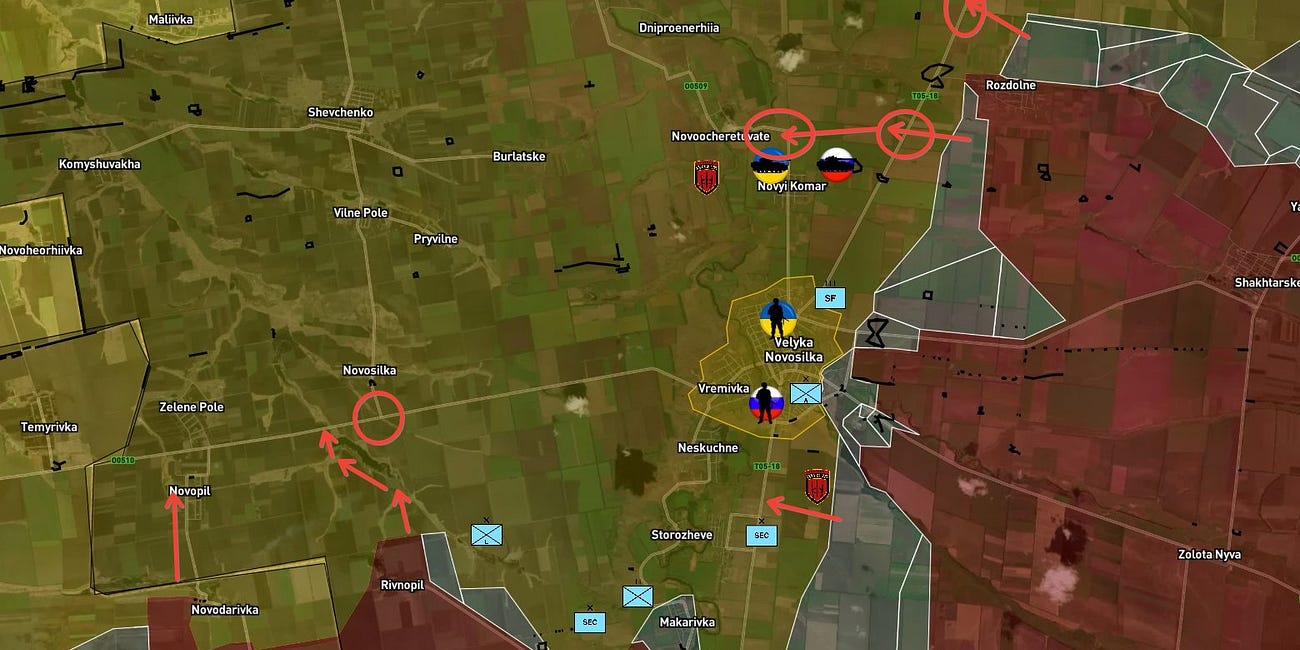



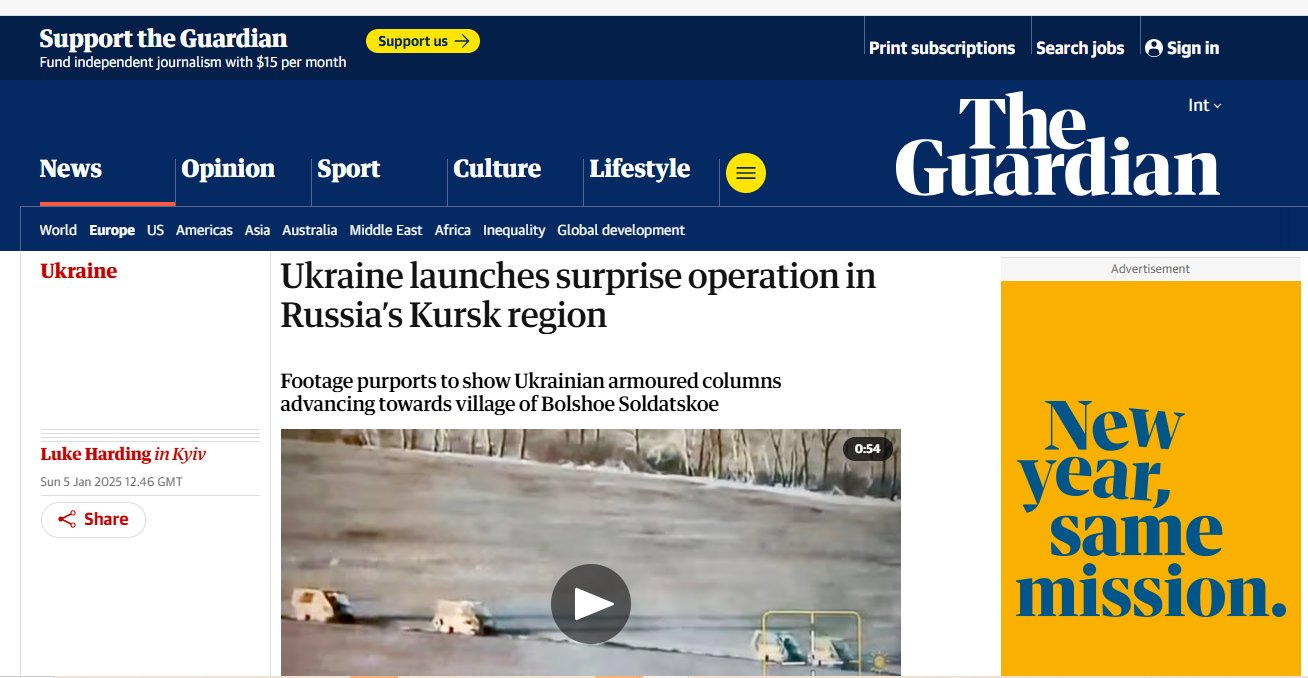
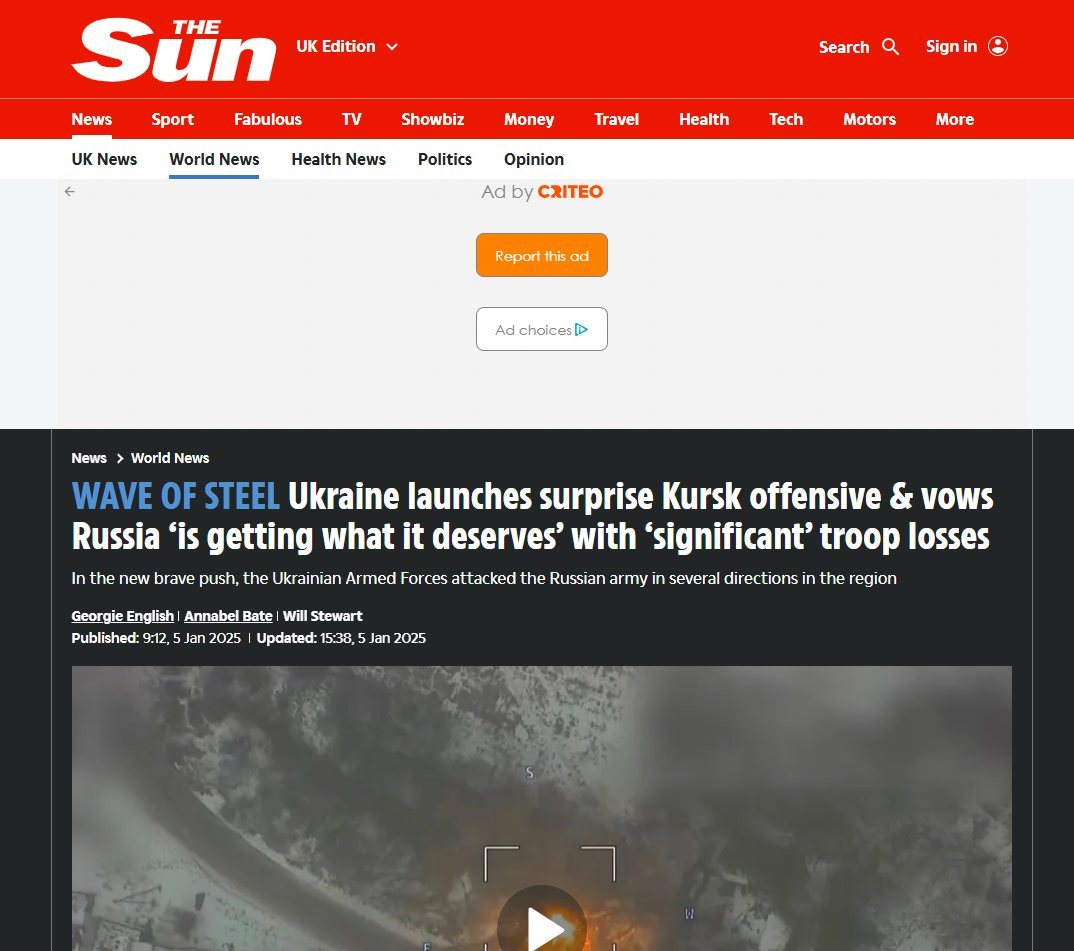

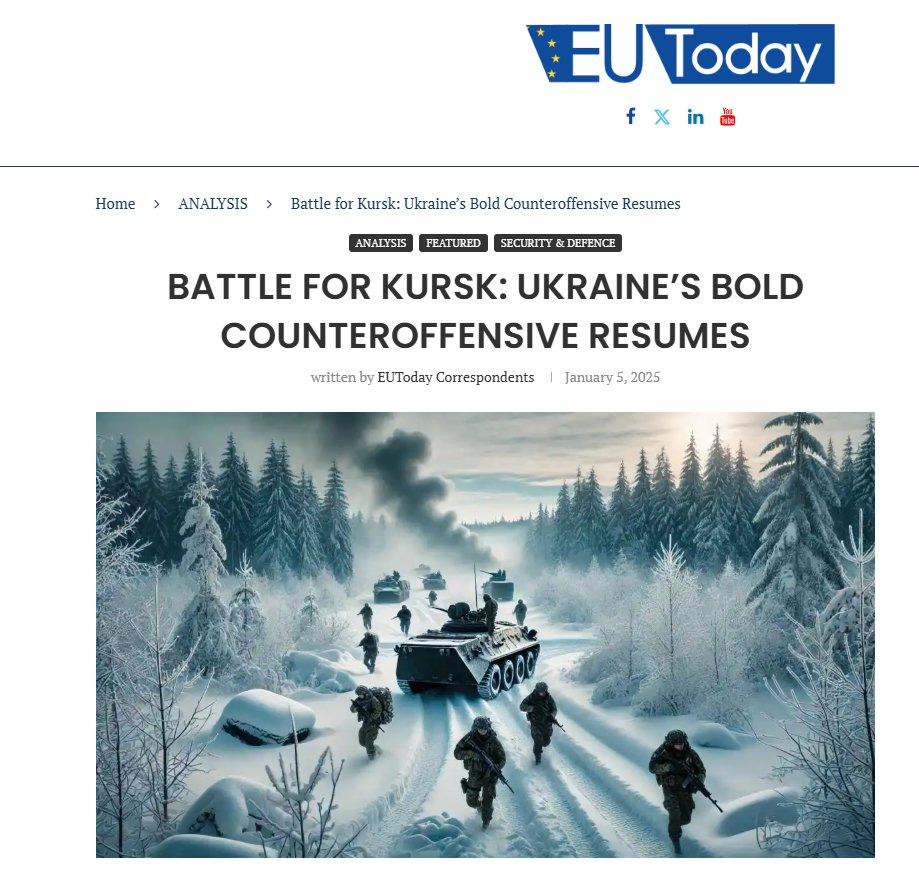


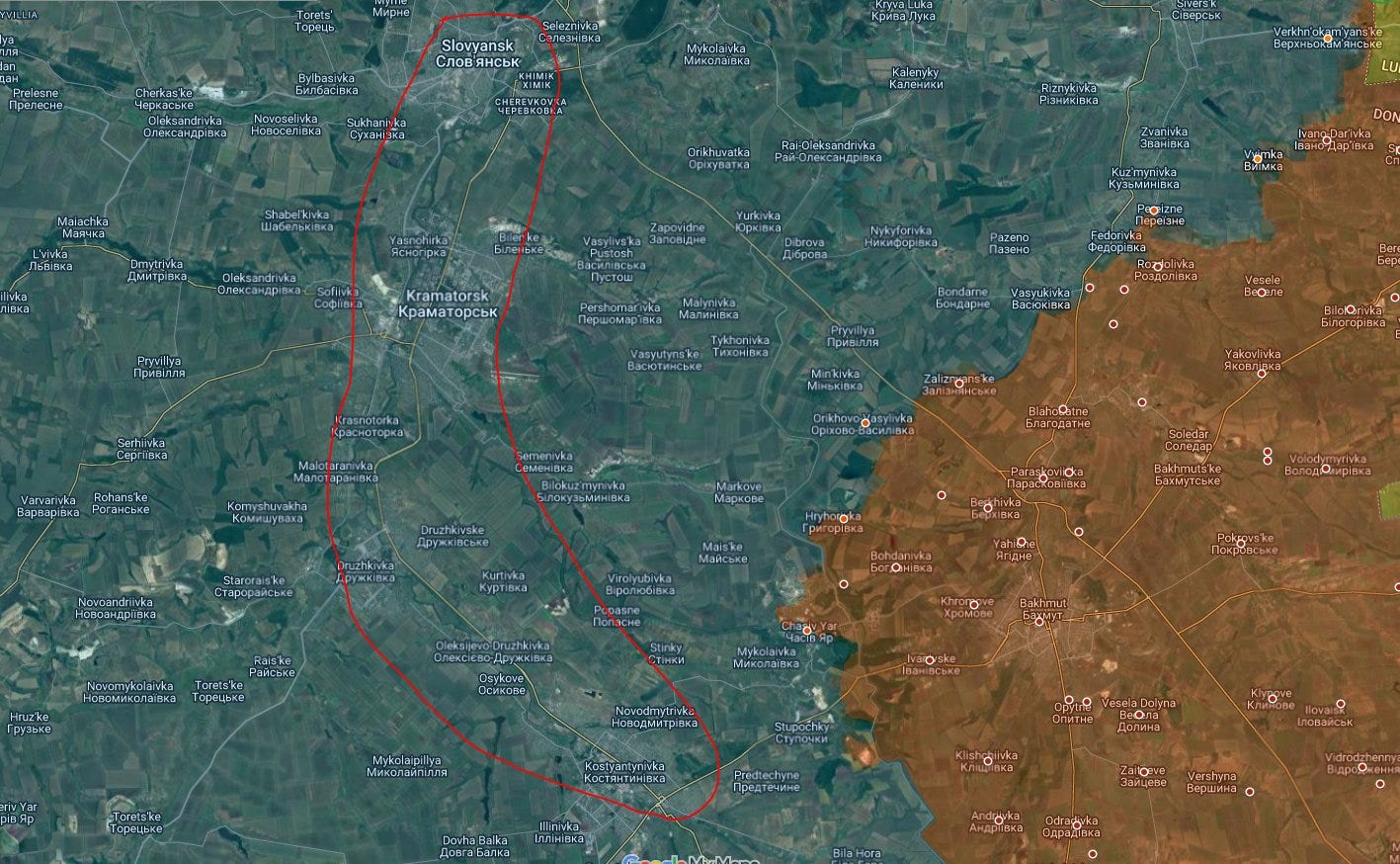

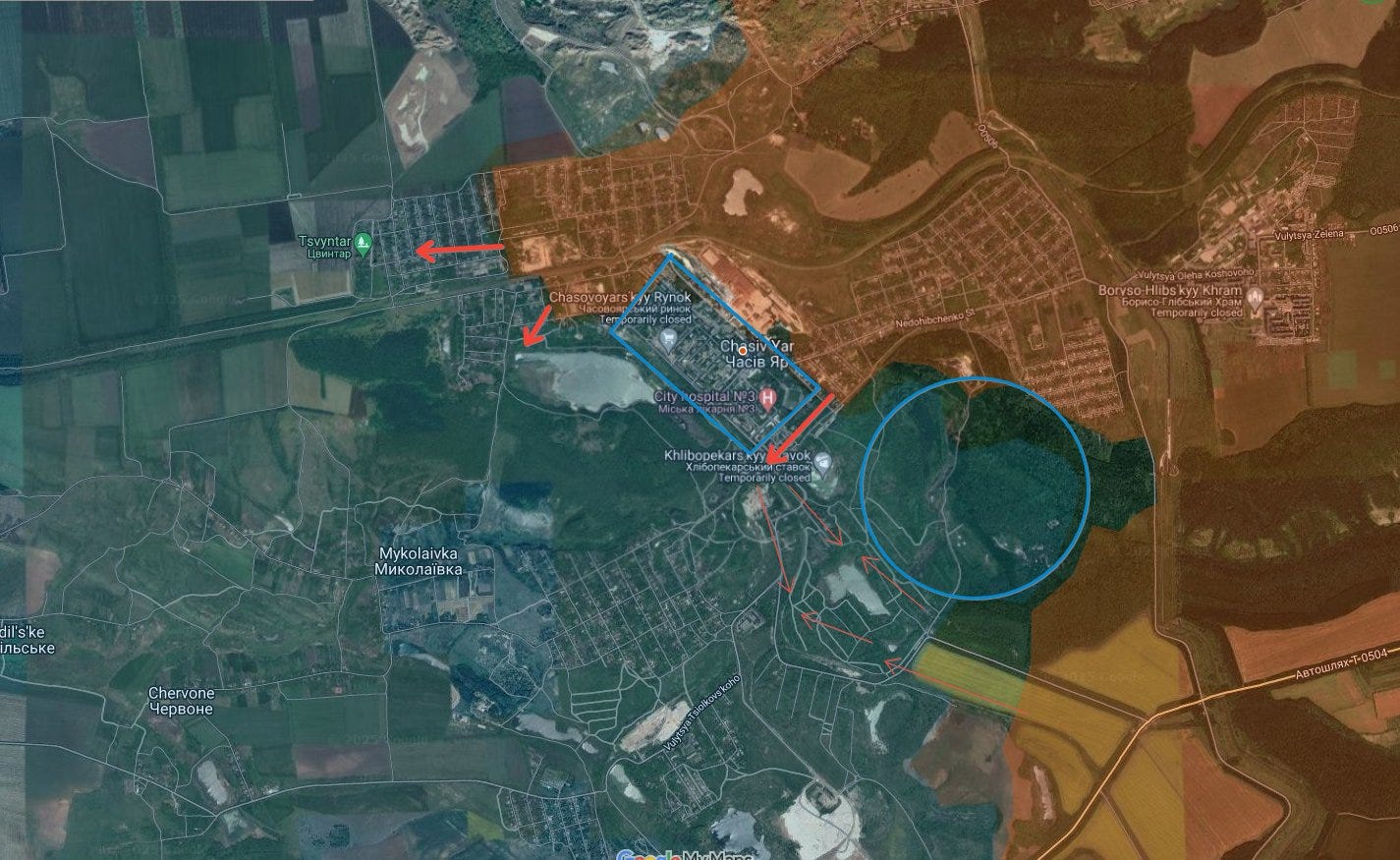

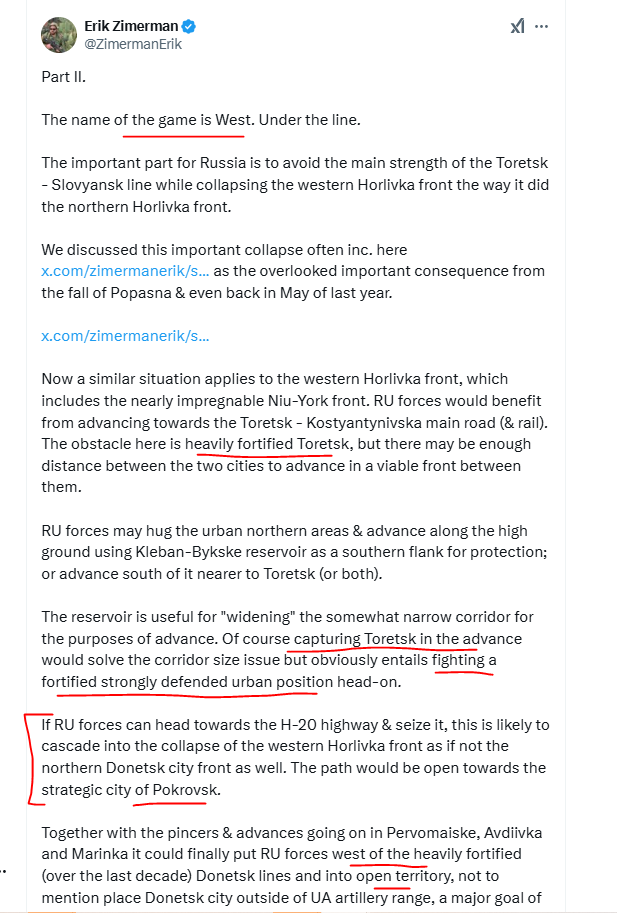
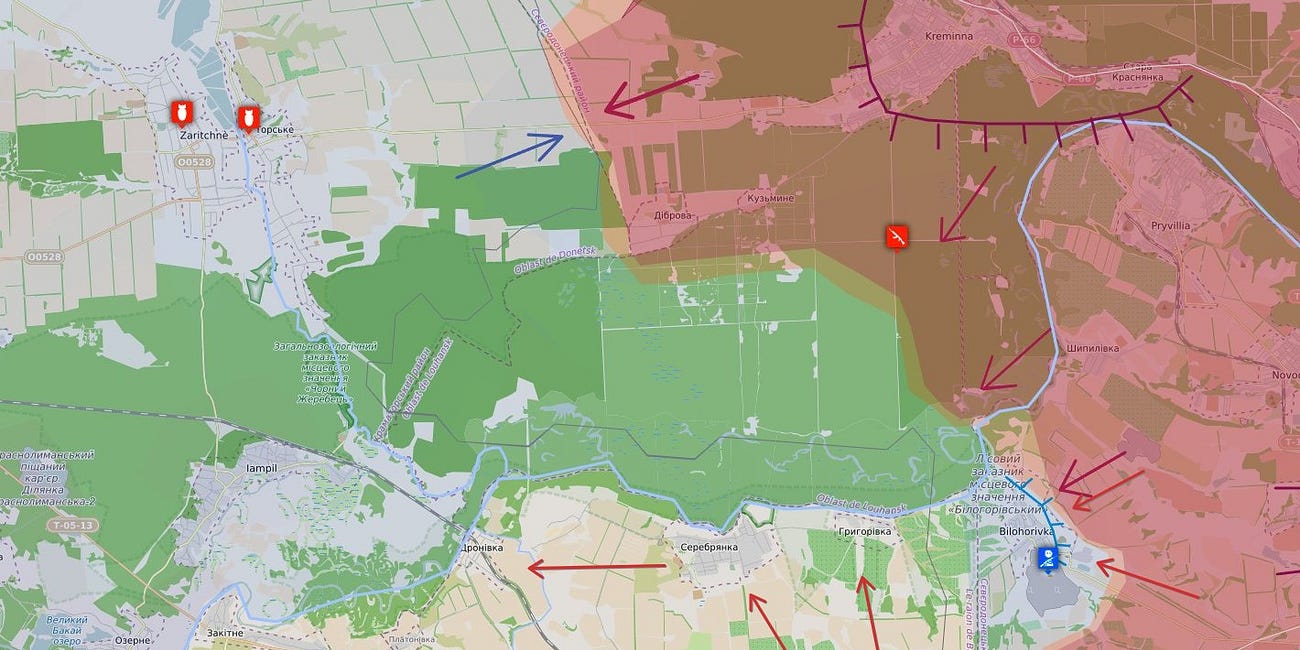
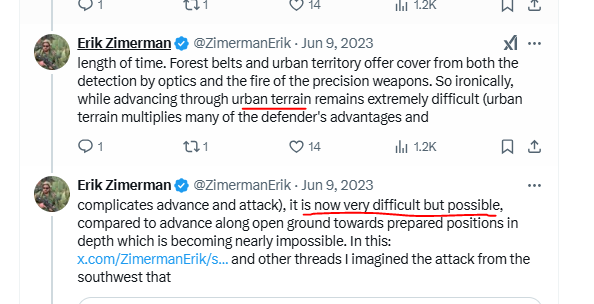



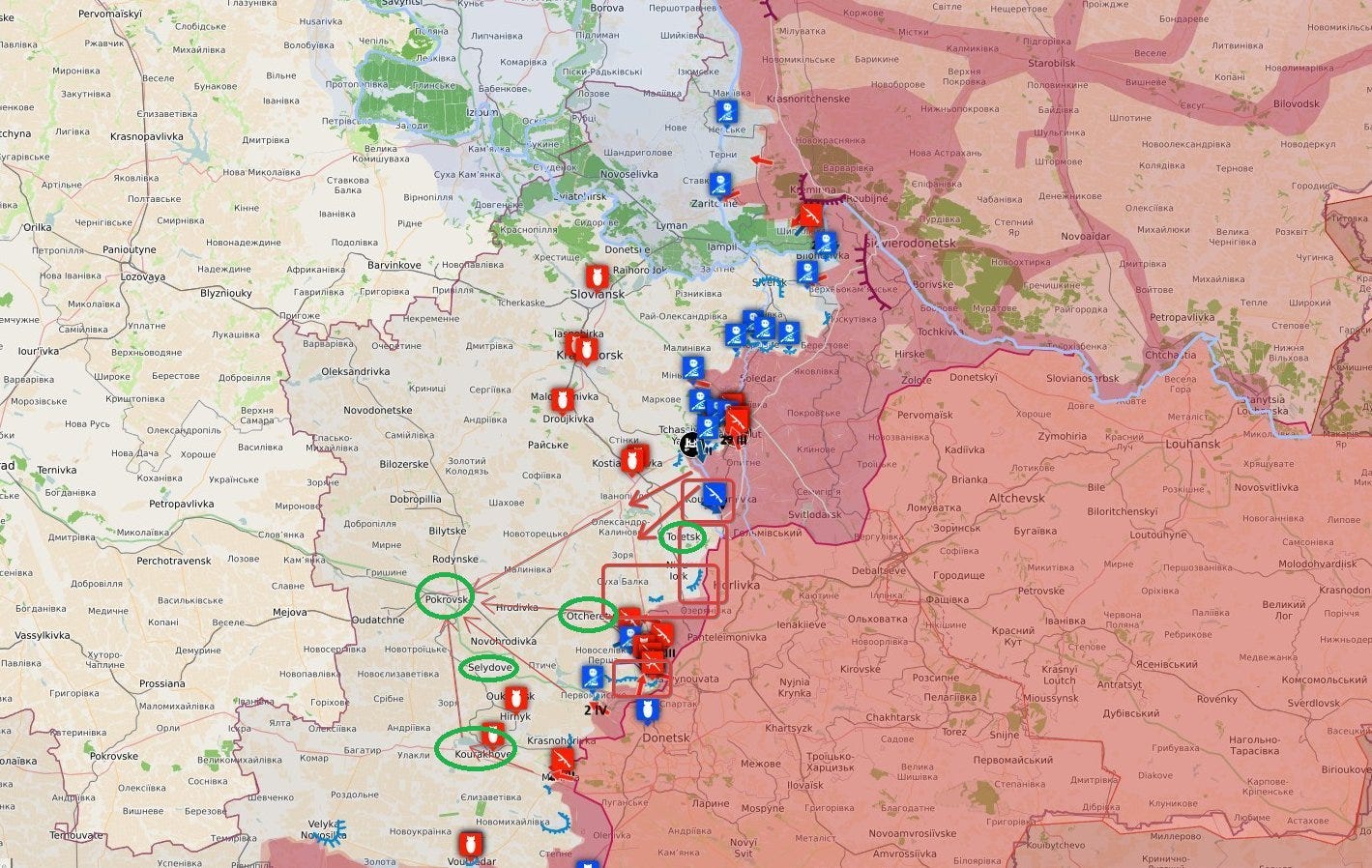

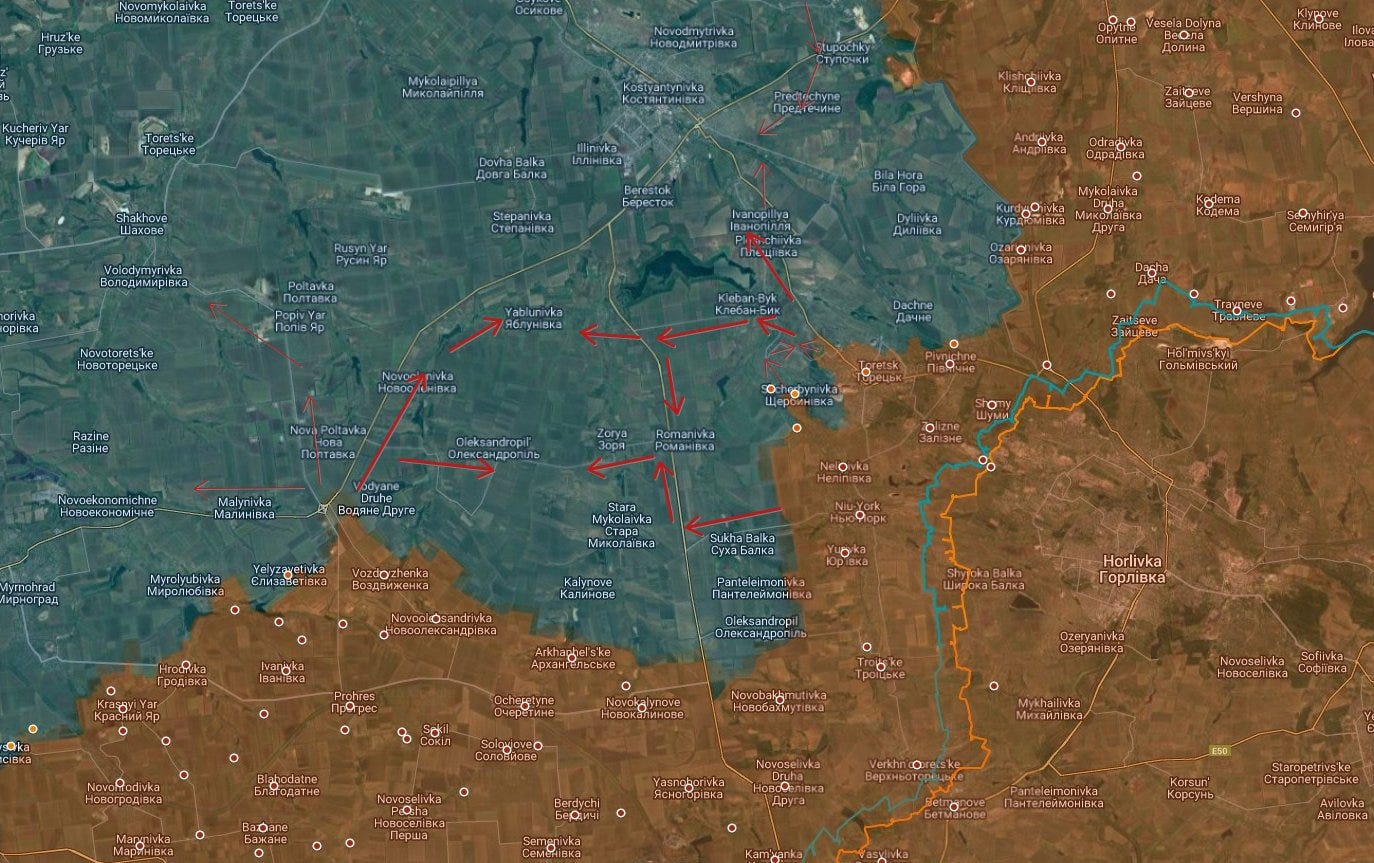





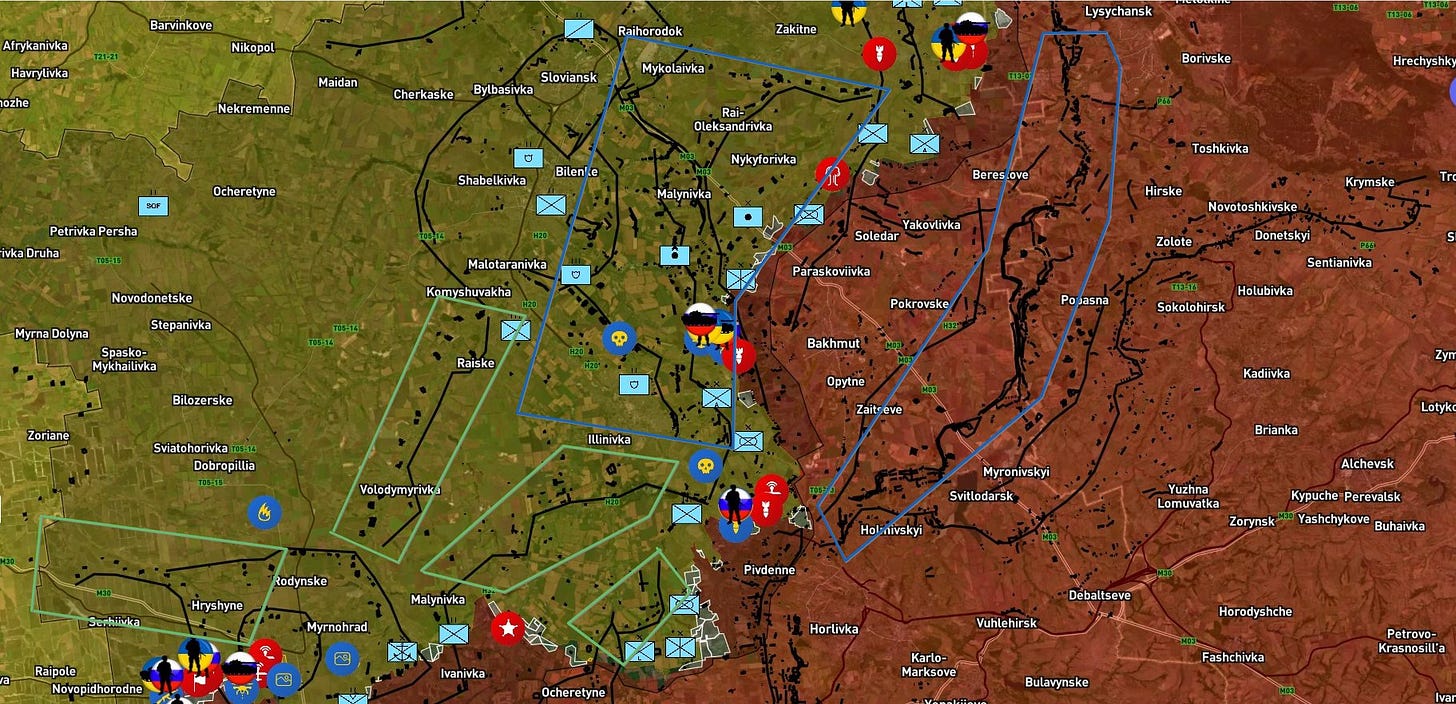

Excellent analysis and Mazal Tov on your prophetic predictions. Who said the Age of Prophecy is over?
If Russia manages to break out into the blue then the Wokes will of course blame Trump.
----
You correctly pointed out a few months ago that Trump had little leverage over Putin.
The new Trump Bibi deal has given Trump important additional leverage including:
- threat of war winning Israeli weapons systems to Ukraine (major change of Israeli policy has gone almost unremarked in media);
- Israeli agreement (or not) to some Russian role in Syria as counter to Turkey.
------
There is also a broader issue of whether the Trump Administration sees Russia or the Woke Mind Virus (Globalist Woke Socialism) as a greater threat to its national security.
If Europe won't vote out its Wokes, the US might decide to let Putin have Europe so it can be de-woked the Russian way.
The Europeans think the US is their sugar Daddy and forever protector, but if fact the US was just fighting (in Europe) ideologies (National Socialism and International Socialism) that threatened its national security in WWII and the Cold War.
Traditional Russian Imperialism is not something that really threatens the US and historically the US has kept out of traditional European conflicts.